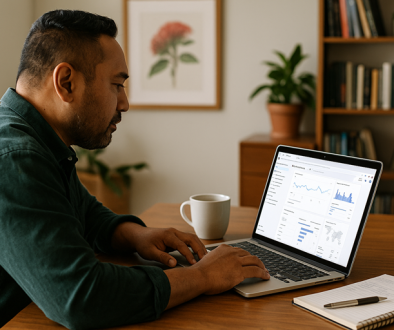Why Your Website Isn’t Ranking (Common SEO Mistakes to Avoid)
Is your website sitting quietly online, not bringing in the leads or clients you hoped for? Many small business owners assume the problem is their design, but the truth often lies deeper.
If your site isn’t ranking on Google—or if it’s attracting traffic but not turning visitors into customers—chances are you’re making one or more common SEO mistakes. The good news? They’re fixable.
Mistake 1: Ignoring Keyword Research
One of the most common reasons websites don’t rank is that they’re not using the words customers actually type into Google. If you’re writing about “residential surface improvements” but your customers are searching for “driveway repairs,” you’ll miss the connection.
The Fix: Spend time doing keyword research. Tools like Google Keyword Planner, Ubersuggest, or AnswerThePublic can help you find the terms your ideal customers are already searching for. Then use those keywords naturally in your titles, headings, and content.
Mistake 2: Thin or Generic Content
Google favours websites that provide real value. If your site has very little text, or if it copies what’s already out there, it won’t stand out. A few sentences on each page isn’t enough to prove your authority.
The Fix: Invest in content that answers your audience’s real questions. Blog posts, FAQs, and case studies all build trust. Aim for 800–1,200 words per article with practical advice, examples, and clear explanations.
Mistake 3: No Local SEO Setup
Many NZ small businesses miss out on local customers because they haven’t set up or optimised their Google Business Profile. Without it, you won’t show up in map searches or “near me” results, even if you’re right around the corner.
The Fix: Claim your profile, fill out every detail, upload photos, and post updates regularly. Encourage happy customers to leave reviews—these are powerful ranking signals.
Mistake 4: Slow or Non-Mobile-Friendly Websites
If your site takes more than a few seconds to load, or if it doesn’t display well on a phone, both Google and your visitors will click away. With most searches happening on mobile, this is a deal-breaker.
The Fix: Compress images, use a reliable host, and check your site’s speed with Google PageSpeed Insights. Make sure your site design adapts to all devices.
Mistake 5: Skipping Meta Titles and Descriptions
Meta titles and descriptions are the text snippets that show up in search results. If you don’t write them, Google guesses—and the results may not be appealing or relevant.
The Fix: Write unique titles and descriptions for each page. Include your keyword and make them compelling enough to earn a click.
Mistake 6: Poor Conversion Strategy
Even if your site does rank and attract visitors, you may still feel like it’s “not working.” Why? Because it doesn’t filter or qualify leads. Too many small business sites just have a “Contact Us” form and nothing more, which wastes time chasing unqualified prospects.
The Fix: Think about your strategy, not just your design. As I explain in the video above, one of my clients—a house painter—was chasing poor-quality leads every week. His site attracted interest, but most people weren’t serious or didn’t understand the cost.
We fixed it by adding a custom estimate tool. Now, visitors enter details, see a price range, and only serious leads get through. It’s a simple automation that saves hours each week and ensures his site finally supports his business goals.
Mistake 7: Neglecting Backlinks
Backlinks (links from other websites to yours) are still one of the most powerful ranking factors. If no one else is linking to your content, Google won’t see you as an authority.
The Fix: Start small. List your business on local directories, collaborate with complementary businesses, or create content worth sharing. Over time, quality backlinks build authority and rankings.
Mistake 8: Not Tracking Performance
If you’re not monitoring your SEO, you won’t know what’s working. Too many business owners “set and forget” their website, hoping it’ll magically climb the rankings.
The Fix: Set up Google Analytics 4 and Google Search Console. These free tools show you where your traffic comes from, which keywords drive visitors, and how people interact with your site.
Why Strategy Beats Design
SEO isn’t just about appearances—it’s about function. A beautiful website that doesn’t attract or convert leads is like a shop with no sign out front. As I often tell my clients, the problem isn’t usually the design—it’s the strategy.
Your site should qualify the right people, filter out the wrong ones, and save your team time. When you get this right, SEO becomes part of a bigger business growth plan, not just a marketing buzzword.
How I Can Help
As a business consultant, I help small business owners bridge the gap between SEO, marketing, and operations. Instead of disconnected advice, I provide systems that actually work together. From fixing SEO mistakes to creating tools that pre-qualify leads, my focus is on strategy, automation, and results.
If your business has hit that awkward stage where marketing, tech, and growth all feel disconnected, let’s talk. Book a quick Zoom call via my contact page. You’ll walk away with at least one practical idea to save time and grow.
Conclusion
Many websites don’t rank because of avoidable mistakes: missing keywords, poor content, slow speed, or no conversion strategy. By fixing these common SEO mistakes—and combining SEO with smarter business systems—you’ll not only rank higher on Google, but you’ll also attract the right clients and stop wasting time on the wrong ones.
A great website isn’t just about being visible—it’s about being effective.



